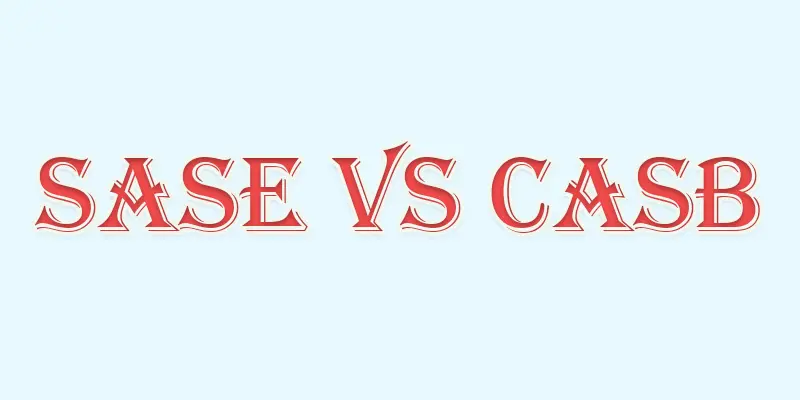CASB vs SASE | Which Cloud Security Solution is Right for You?
Published: 13 Feb 2025
CASB vs SASE
Did you know that SASE and CASB are both essential for modern cloud security? But how do they differ, and which one do you need? If you’re struggling with managing cloud app security and ensuring safe access for remote teams, understanding the differences between SASE and CASB is crucial. Let’s break it down so you can choose the right solution for your business needs.
What is SASE
SASE (Secure Access Service Edge) is a cloud-based framework that combines networking and security into one unified solution for better protection and access.It helps businesses protect data, users, and applications from cyber threats while ensuring safe and fast access.

What is CASB
CASB (Cloud Access Security Broker) is a security tool that protects cloud applications by monitoring and controlling user access. It helps prevent data leaks, enforces security policies, and detects threats in cloud services.
Difference Between SASE and CASB
SASE and Casb are both crucial for cloud security, but while SASE offers a comprehensive security framework, Casb specifically focuses on securing cloud applications.
| SASE | CASB |
|---|---|
| Integrates security and network services inside a cloud-based architecture. | Focuses on securing cloud applications and data. |
| Provides a broad security solution for networks, users, and cloud services. | Protects cloud environments by monitoring and controlling access. |
| Covers network security, application security, and user access. | Primarily secures cloud applications and data. |
| Includes SD-WAN, firewall, CASB, ZTNA, and other services. | Focuses on cloud app security, including data loss prevention (DLP). |
| Broader: Covers network performance, security, and remote access. | Narrower: Focuses solely on cloud security. |
| Cloud-native often integrates with hybrid or multi-cloud infrastructures. | Typically cloud-based, integrates with cloud apps and services. |
| Provides network-level security and access control. | Manages user access to specific cloud applications and data. |
| Secures data by integrating security into the network and app layer. | Focuses on securing data stored and transmitted in the cloud. |
| Broad network-level security and access control. | Granular security for individual cloud applications. |
| Provides visibility into network traffic and security policies. | Provides visibility into user activities within cloud applications. |
| Optimizes cloud app performance through SD-WAN and other features. | Doesn’t directly optimize performance, but ensures secure cloud usage. |
| Integrates seamlessly with cloud platforms and networks. | Specifically designed to work with cloud services and apps. |
| Replaces traditional VPNs by offering secure cloud access and network optimization. | CASB can be used in conjunction with VPNs for enhanced cloud security. |
| Mitigates risks through integrated network and cloud security solutions. | Mitigates risks by preventing unauthorized access and data breaches in the cloud. |
| Enforces network-wide security policies across all cloud services. | Enforces cloud-specific security policies for individual apps and users. |
| Best for large-scale organizations needing holistic network and cloud security. | Ideal for businesses focused on securing cloud applications and data. |
| Can be more expensive due to the comprehensive nature of the solution. | Generally more affordable and specialized for cloud security. |
| A global company uses SASE to secure network traffic, cloud apps, and users for its distributed workforce. | A company uses CASB to monitor cloud apps and prevent unauthorized data sharing. |
| Helps meet compliance by securing data and network access. | Focuses on ensuring compliance with cloud-based data regulations (e.g., GDPR). |
Conclusion About CASB vs SASE
CASB is a security tool that protects cloud applications by monitoring and controlling user access. When comparing SASE vs CASB, CASB is best for securing cloud apps, while SASE provides a complete network and security solution. I recommend businesses using multiple cloud applications start with CASB, but for full security, integrating SASE is a smarter choice. Want to explore the best security solution? Read our in-depth guide now!
FAQS – Difference Between CASB and SASE
CASB (Cloud Access Security Broker) protects cloud apps by controlling access and preventing data leaks. To identify risks throughout a network, SIEM (Security Information and Event Management) gathers and examines security logs.
No, CASB is not a firewall. It focuses on securing cloud applications, while a firewall protects a network by blocking unauthorized traffic.
The main purpose of CASB is to secure cloud applications by monitoring access, enforcing security policies, and preventing data leaks.
CASB tools are security solutions like Microsoft Defender for Cloud Apps, Netskope, McAfee MVISION Cloud, and Palo Alto Prisma Cloud that help protect cloud applications.
CASB architecture includes four main components: API-based security, forward proxy, reverse proxy, and log collection, all working together to secure cloud access.
Data Loss Prevention (DLP): Stops sensitive data from being shared or leaked.
Shadow IT Detection: Identifies and monitors unauthorized cloud applications used in a company.
Yes, Microsoft offers a CASB solution called Microsoft Defender for Cloud Apps, which helps protect cloud applications by monitoring access, enforcing policies, and detecting threats.

- Be Respectful
- Stay Relevant
- Stay Positive
- True Feedback
- Encourage Discussion
- Avoid Spamming
- No Fake News
- Don't Copy-Paste
- No Personal Attacks

- Be Respectful
- Stay Relevant
- Stay Positive
- True Feedback
- Encourage Discussion
- Avoid Spamming
- No Fake News
- Don't Copy-Paste
- No Personal Attacks





